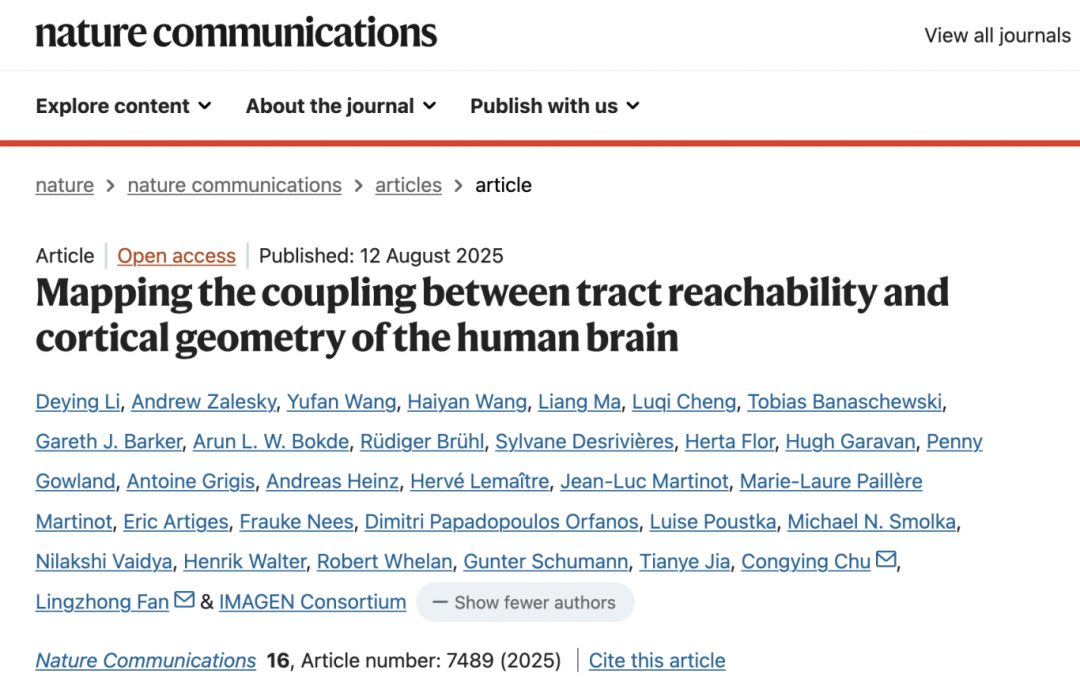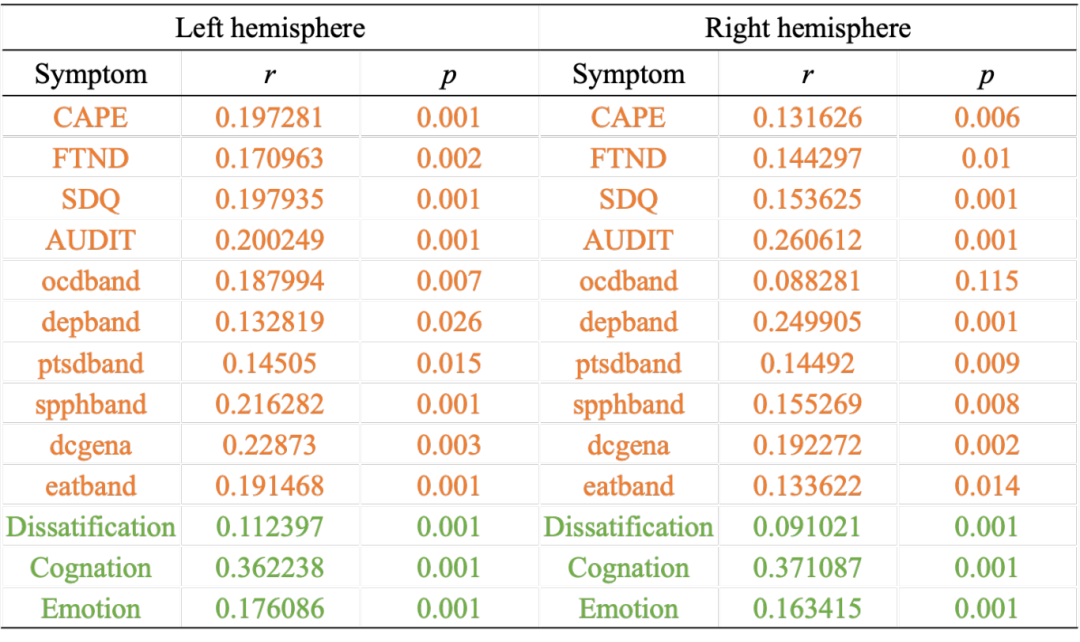Study Reveals the Secrets of Brain "Folding" and "Wiring": A Symphony of Gray and White Matter
Font:【B】 【M】 【S】
When we think, remember, or feel, the white matter fiber bundles in the brain act like highways transmitting information, while the complex cortical folds resemble mountains and valleys on a map, providing unique pathways for this information. For a long time, scientists have often studied cortical morphology (cortical geometric patterns) and white matter pathways (fiber tract connections) separately, rarely exploring their relationships. This limitation means we may have overlooked crucial clues to understanding the overall functioning of the brain.
Recently, the Brain Network Research Team of The Laboratory of Brain Atlas and Brain-Inspired Intelligence, Institute of Automation, Chinese Academy of Sciences, revealed the intrinsic relationship between human cortical geometric patterns and white matter fiber connections, and proposed a new metric called “Tract-Geometry Coupling (TGC).” The study, entitled Mapping the coupling between tract reachability and cortical geometry of the human brain, was published in Nature Communications.

White matter fibers establish anatomical connections between different brain regions, forming the brain’s “connectome,” much like a vast and precise transportation network that ensures smooth information transmission across functional areas. At the same time, the complex folding of the cortex greatly increases surface area within the limited cranial cavity, allowing more neurons and connections to be accommodated, thereby supporting complex functions. Research shows that these two are not independent during development but continuously influence each other: beginning in the fetal stage, white matter fibers support outward cortical expansion; cortical folding, in turn, exerts tension on white matter, altering fiber trajectories. This dynamic interaction persists throughout childhood and adolescence until stabilizing in adulthood. Clinical cases also confirm this coupling: when severe trauma damages white matter, cortical morphology also changes, often accompanied by cognitive or emotional disorders. Therefore, establishing and quantifying the coupling between cortical geometry and white matter pathways is crucial for understanding changes in the brain during development, maturation, and aging.

To quantify this coupling, the team used high-resolution multimodal magnetic resonance imaging (MRI) data to characterize cortical geometry and white matter fiber bundles. For cortical geometry, they derived a series of geometric eigenmodes at different frequencies through mathematical decomposition. This complete basis set can describe patterns of cortical connectivity and activation under both task-induced and resting states. For fiber tracts, they used diffusion MRI to map probability distributions of 36 major white matter fiber bundles terminating on the cortical surface, thereby representing cortical projection patterns. Results showed that cortical geometric eigenmodes could highly accurately reconstruct termination distributions of fiber bundles, much like terrain determines river flow. They termed this quantitatively characterized relationship “Tract-Geometry Coupling (TGC).” TGC is highly stable across repeated measurements and can serve as a “fingerprint” to distinguish and identify individuals.

Construction of Tract-Geometry Coupling
Further analysis of TGC revealed different roles of geometric eigenmodes at different frequencies. Low-frequency eigenmodes represent large-scale, smooth morphological structures, strongly influenced by genetics; high-frequency eigenmodes capture finer, localized structures, often shaped by environmental factors such as life experiences and learning. This suggests that human brain structure not only follows an innate blueprint but is also continuously shaped by experience throughout life. Moreover, the study found that projection fiber tracts showed higher heritability in their coupling with cortical geometry, consistent with their conserved roles in individual development and evolution.

Heritability analysis of TGC
TGC not only characterizes the coupling between cortical geometry and white matter connections but also relates closely to function and behavior. The study showed that TGC could reproduce brain activation patterns across multiple task states, indicating that it reflects not only anatomical structure but also functional characteristics. Interestingly, TGC can predict cognitive and behavioral indicators such as intelligence, emotional state, and addiction tendency. This predictive ability outperforms models using only white matter connection features. Among adolescents, TGC at age 14 could even predict cognitive performance at ages 19 and 23, providing a new reference for early education and intervention.

TGC can predict multiple cognitive and behavioral indicators
Childhood and adolescence are critical stages of rapid brain structural remodeling, during which TGC shows significant changes in many key fiber bundles. Most white matter fiber bundles dynamically evolve in their coupling with cortical geometry, and those with significant developmental patterns often show stronger coupling. Fiber bundles associated with language, such as the arcuate fasciculus, superior longitudinal fasciculus, and uncinate fasciculus, not only exhibit higher coupling values but also faster growth rates, playing central roles in the development of language, emotion, and executive functions. Abnormal coupling between these fiber bundles and cortical geometry during adolescence is linked to disorders such as schizophrenia and depression, which often involve impairments in language processing, emotional regulation, and cognitive control. Tracking the coupling trajectories of these fiber bundles and cortical geometry may help uncover disease mechanisms and provide scientific evidence for early intervention during high-risk stages.

Developmental trajectories of TGC
The complexity and subtlety of the human brain far exceed our imagination, and this study opens a new window for understanding how “shape + wiring” work together to support cognition and behavior. TGC can serve as a reference for assessing child cognitive development, early detection of mental disorders, and research into personalized treatment, helping to explore how variations in these couplings relate to neurological and psychiatric diseases and supporting the development of new diagnostic tools and treatment strategies targeting specific white matter pathways.
The first author of the paper is Deying Li, a doctoral student at The Laboratory of Brain Atlas and Brain-Inspired Intelligence, Institute of Automation, Chinese Academy of Sciences (currently pursuing further studies at the Donders Institute for Brain, Cognition and Behaviour in the Netherlands). Researcher Lingzhong Fan and Associate Researcher Congying Chu of The Laboratory of Brain Atlas and Brain-Inspired Intelligence, Institute of Automation, Chinese Academy of Sciences, are the corresponding authors. The paper’s collaborators include Professor Andrew Zalesky of the University of Melbourne, Professor Tianye Jia of Fudan University, and Associate Professor Luqian Cheng of Guilin University of Electronic Technology. This study was supported by the National Science and Technology Innovation 2030 Major Project “Brain Science and Brain-Inspired Research” and the National Natural Science Foundation of China.
Paper information:
Li, D. et al. Mapping the coupling between tract reachability and cortical geometry of the human brain. Nature Communications 16, 7489 (2025).
DOI: https://doi.org/10.1038/s41467-025-62812-9
Copyright Institute of Automation Chinese Academy of Sciences All Rights Reserved
Address: 95 Zhongguancun East Road, 100190, BEIJING, CHINA
Email:brain-ai@ia.ac.cn